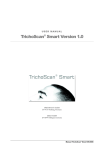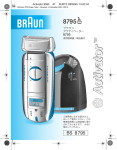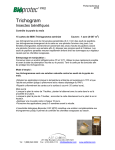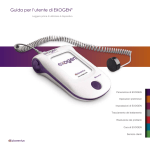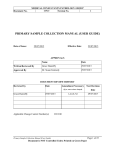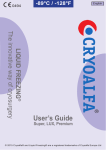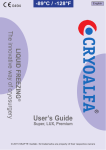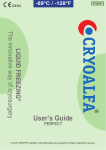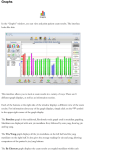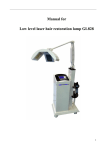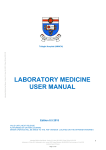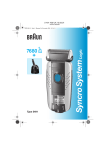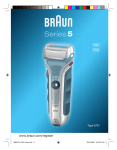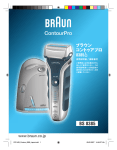Download TrichoScan Professional Version 3.0
Transcript
USER MANUAL TrichoScan Professional Version 3.0 TRICHOLOG GmbH 79117 Freiburg, Germany Datinf GmbH 72074 Tübingen, Germany Manual TS 3.0 08/2007 Contents Introduction 3 Background 3 Measuring method of TrichoScan TrichoScan - Definitions 3 TrichoScan - Procedure 4 4 A – Determination of total, terminal, and vellus hair density and telogen hair counts Preparing the patient Choosing the optimal measurement site Dying the hair Removal of hair dye Recording the images 6 6 6 9 9 14 B – Determination of anagen hair count 16 Software description 18 Image transmission Manual control Printing the results Support Certification Initialization data Parameters 18 18 18 19 19 19 20 Appendix 20 References 20 Examples of TrichoScan target sites 21 Examples of unsuitable TrichoScan images 24 Manual TS 3.0 08/2007 Introduction Background Hair loss or thinning hair is a common complaint in clinical dermatology, but patients seeking advice for hair loss are not necessarily going bald. In established cases of androgenetic alopecia (AGA) characteristic patterns are easily discernible. However, the clinician is often challenged by patients, especially females, with initial stages of AGA where hair loss is reported but alopecia is not visibly discernable, or where the effect of treatment attempts are hard to measure. Numerous methods have been described to assess the rate of hair growth. The techniques can be classified as either invasive (e.g. biopsies), semi-invasive (trichogram, unit area trichogram) or non-invasive methods. However, while reviewing the capabilities of the different methods, the common theme emerges that most techniques are of little use to the clinician because they are time consuming, often costly, or difficult to perform. Therefore, an operator- and patientfriendly, inexpensive, validated and reliable method of quantifying hair growth is a rational need. TrichoScan is such a method, combining standard epiluminescence microscopy (ELM) with automatic digital image analysis, for the measurement of human hair. Measuring method of TrichoScan With the TrichoScan 3.0 version several different needs in hair science are met. Firstly, the most important parameters, such as total terminal and vellus hair counts, can be analysed within the same day. Secondly, the same target site can be used to calculate the number of telogen hairs by mathematical approximation; and thirdly, with a different hair shaving procedure, the anagen hair count is also measurable. This handbook will guide you through the different possibilities. 3 TrichoScan - Definitions A: TrichoScan-Professional V 3.0 is suitable for the analysis of human scalp hair in androgenetic (pattern) alopecia. B: TrichoScan is a tool to monitor the most important hair parameters during treatment. C: TrichoScan-Professional V 3.0 is able to monitor total, vellus, and terminal hair density and, by mathematical approximation, the telogen and the anagen hair count. D: TrichoScan is not suitable for evaluating body hair or to monitor other hair diseases such as alopecia areata. E: TrichoScan is not a diagnostic procedure. F: TrichoScan-Professional V 3.0 is not designed for clinical trials. It is made for the individual clinician in practice. We do not accept any responsibility when the tool is used for clinical trials. G: The TrichoScan-analysis needs a clean and lightly pigmented skin to enable good contrast with dark colored hair. Any remnants of the hair dye, dark melanocytic moles or dark scalp skin will diminish the contrast to the hairs and the analysis will not be possible. F. TrichoScan is a software program based on statistics and definitions of hair patterns. The software cannot diagnose telogen or anagen hair loss like a histopathologist. However, based on the biological behavior of those hairs, they can be differentiated by mathematical approximation. TrichoScan-Procedures There are two possible basic procedures that provide different information with Trichoscan Professional V 3.0: A - Determination of total, terminal, and vellus hair density (at the time of hair clipping) and optional telogen hair counts (3 days after incomplete hair clipping). B – Determination of anagen hair count (dyeing and measuring hair 3 days after complete shaving). 4 TrichoScan – Hair parameters Hair density (n/cm2): With the TrichoScan-Professional V 3.0 edition it is possible to calculate the number of hairs detected (hair count) and the hair density (hairs / cm2). Please note, that due to the image resolution of digital cameras the TrichoScan software cannot detect very fine hairs (approx. less than 10µm diameter). In addition, TrichoScan cannot identify hairs which are too short for analysis (approx. less than 0.3mm in length). As digital camera image resolution improves, these limitations may change in the future. Terminal hair density (n/cm2): By definition a terminal hair is thicker than 40µm. Trichoscan uses this value to identify terminal hairs in images. The number of terminal hairs relative to vellus hairs is also calculated and provided in the analysis results. 2 Vellus hair density (n/cm ): By definition a vellus hair is thinner than 40µm. Trichoscan uses this value to identify vellus hairs in images. The number of vellus hairs relative to terminal hairs is also calculated and provided in the analysis results. Telogen hair density (n/cm2): By definition a terminal hair will not grow whereas anagen hairs will. When images are taken three days after hair clipping, growing hairs can be differentiated from nongrowing hairs based on different hair length. Trichoscan identifies non-growing hairs as telogen hairs and growing hairs as anagen hairs. 2 Anagen hair count (n/cm ): In the definition of the TrichoScan procedure, an anagen hair is a hair which is detectable three days after complete hair shaving. Within this time only anagen hairs should grow significantly. 5 A – Determination of total, terminal and vellus hair density TrichoScan can measure the most important parameters of hair growth immediately following correct preparation of the scalp region for analysis. The following steps are necessary. Preparing the patient There is no special recommendation. The patient may wash their hair before the analysis. Choosing the optimal measurement site The use of TrichoScan requires a representative area of the scalp to be shaved. To achieve a cosmetically acceptable result, the following should be observed. Areas unsuitable for shaving are: • • The parting The occipital whorl So that the hairs in close vicinity can be combed over the shaved area and thereby create an aesthetically satisfactory result, the shaving should take place two fingers width away from the parting (fig. 1), on the receding hairline of the fronto-temporal regions or on the vertex. The mask is applied and hair in the selected area is pulled through the mask (figs. 2 and 3). The hair exposed through the mask is shaved (fig. 4) to leave a small neat spot (fig. 5). 6 Fig 1: The shaving mask is positioned about two fingers width away from the parting or any other suitable measurement site. Fig 2: The hair in the area to be shaved is exposed with a curved hook or with pointed scissors. 7 Fig 3: Hair after exposure is clipped. Fig 4: Exposed hair, should not be completely clipped down to the bare scalp. Best results are achieved by a speedy and gentle clipping process. Some stubble must remain. 8 Fig 5: After clipping, the clipped hairs can be removed with sticky tape. The hair must not be clipped down to the scalp surface. Short hair shafts should remain visible (ideally approx. 0,5 – 1 mm in length). This is achieved by a diagonal shaving technique (fig. 4). Dying the hair Hairs do not normally contrast well enough with the scalp skin for digital photography and need to be dyed in advance of taking digital images. The dye product supplied with TrichoScan is best applied using a wooden spatula after having been mixed 1:1 with development cream (figs. 6-10). The dye is applied onto the clipped scalp area and must remain there for 15 minutes. Longer dying periods lead to dyeing of the scalp skin, shorter periods lead to inadequately dyed hair! Both results are equally unsuitable for subsequent evaluation. Removal of hair dye After 15 minutes the hair dye must be completely removed. This is TM best done with an alcoholic solution such as Kodan Spray , a clean swab and some gentle pressure and rubbing of the measurement site. 9 Fig 6: A small amount of the dye supplied with the Trichoscan kit is applied onto a wooden spatula or similar utensil. Fig 7: The same amount of dye development cream is applied to the spatula. 10 Fig 8: The dye and development solution are mixed together. Fig 9: After mixing of the dye and development solution the mixture is ready for application to the clipped scalp region using the wooden spatula. 11 Fig 10: The dye must remain on the scalp for 15 minutes. After dying the hair, the area should be thoroughly cleansed using an alcohol-based solution (Image 11 and 12). Fig 11: Dye remnants should be removed by means of a swab and an alcohol solution. 12 Fig 12: The area should thoroughly be cleansed of all dye remnants. Fig13: Rules for best TrichoScan images: 1. No hair dye remnants should remain. 2. The target area should be wet from the alcohol spray. 3. Images should be taken without contaminating air bubbles present. 4. No hairs from the outside should cross the field of view. 5. Hair stubble of at least 0.5 mm should still be present. 13 Recording the images For recording, the lens of the digital camera's optical attachment is pressed on the wet measurement area. Please use an alcohol spray or tap water to wet the area sufficiently. This obligatory procedure makes sure that no air bubbles are trapped between the scalp and the lens. Oil is not a suitable alternative to the alcohol spray or water. Fig14: A perfect Trichoscan image. Fig15: A perfect TrichoScan image. 14 Suitable Images for TrichoScan As an automated image analysis tool, the TrichoScan results strongly depend on the image quality. Suitable images include the following attributes: - Clean and sharp images with no hair dye remnants. - Wet hairs without larger air bubbles present. - In focus with no long hairs passing into the measurement site from outside. - Hairs are evenly clipped and dark due to the hair dye. - Hairs have a minimum length of approximately 0.5 mm to allow detection by the TrichoScan software. Stubbles that are too short will escape the analysis as the software algorithms define hair as being longer than 0.5 mm. - Hairs that are straight. Avoid twisting the optics whilst placed on the measurement site and be sure that all hairs are evenly clipped. - TrichoScan analysis is not possible in darker skin types or an area with dark melanocytic moles due to poor contrast between skin and hair. Then the image is ready for the analysis of total, terminal, and vellus hair counts. Telogen hair count In the software sense a telogen hair is a non-growing hair. For this analysis the hair should be clipped as above (figs. 1-5) during the first office visit. The patient must return to your office 3 days after hair clipping and then the target area receives the hair dye as described (figs. 6-12) and an image is taken for TrichoScan analysis (figs. 1315). The software will measure the length of all hairs and by statistical analysis will discriminate between growing versus non-growing hairs. Please note that catagen and exogen hairs also do not grow significantly within this time period and will also be judged as non-growing hairs. Therefore, the calculated telogen hair values will be a bit higher than may normally be expected. For this analysis to be accurate a very uniform hair clipping is mandatory to ensure the remaining hair stubble is of equal length. For less expert hair clippers, we recommend the use the anagen hair count tool instead. An anagen hair count requires less hair clipping consistency and so it is much easier to obtain accurate results with this approach. 15 B – Determination of anagen hair count The TrichoScan software defines anagen hairs based on the knowledge that anagen hair grows at approximately 0.3 mm/day whereas telogen and catagen hairs do not grow. Therefore, anagen hair can be calculated by shaving the measurement site; NOT with our TrichoScan clipping machine which will leave some stubbles behind, but with an ordinary single use razor, which will shave all hairs down to the skin completely. Please control with a magnifying loupe and confirm the shaving is indeed complete and no hairs can be detected with the software. After three days the area is then dyed as described above and the image is made. Please note that the calculated hair density will be lower than normally expected as only anagen hairs are measured. Please also note that there are no normal values for the individual patient. During successful treatment, the anagen hair count should increase and therefore this approach can be used to monitor a treatment response. For this procedure you must change the TrichoScan software’s analysis mode to “Anagen hair count”. TrichoScan analysis The recorded photographs are loaded into the TrichoScan software which automatically proceeds with the first analysis. According to the capacity of the computer used, the analysis may take up to one minute (800 MHz – Pentium III) - Faster computers increase the speed of TM the analysis. Macintosh computers cannot be used. 16 Left image (1) Right image (2) Progress indicator Results Diagram Regulator for the outlining of hair lengths Buttons for program navigation Left image (1): Here the area to be analysed has a blue border once the image has been loaded. Right image (2): According to the stage of the analysis, various distinguishing features are marked which give an indication of the progress of the image analysis (red: telogen hair, yellow: hairs that touch the border, green: anagen hair). Result: The results area shows values for the analysed area, including the corrected number of hairs, hair density (number of hairs per area), percentage of anagen hairs, percentage of telogen hairs or density of anagen hairs (depending on mode), vellus hair density, terminal hair density, percentage of vellus hairs, percentage of terminal hairs. Regulator for the outlining of hair lengths: The slider enables the maximal hair length for defining telogen hairs to be manually adjusted by the user when the software is in the “Trichogram” mode. Diagram: The diagram shows the frequency distribution of hair length. The red line marks the maximum length of telogen hairs defined in the software analysis. Buttons for program navigation: Clicking different elements and buttons in the software program window enable different software features: • Click on left image: Fading in and out of the borderline around recognized hairs. • Click on right image: On- and off-switch for the indicator of anagen- / telogenhairs. • Register: This button only applies to program installations used as temporary software evaluation versions. • Score: In “Trichogram” mode a scoring of the analysis is given in the colored field. • Print: Prints the analysis results for documentation. • Change mode: To determine the anagen hair count change to the “Anagen” mode (or change back to “Trichogram” mode). • Cancel: Stops the analysis process. This button does not react immediately during evaluation, it may be necessary to wait a few seconds after clicking this button before the software is seen to respond. • Close: Ends the analysis program. 17 Software description Image transmission The transmission of the digital image to the TrichoScan Software takes place automatically. More details can be found in the documentation for the recording system. Manual control In case the pre-set demarcation line that distinguishes between anagen and telogen hairs does not produce satisfactory results, there is the option of manually setting the maximum length of the telogen hairs. This is achieved by moving the regulator situated above the diagram. Color-coding of the hairs indicates the group they belong to. • • Red: Telogen hair. Yellow: Hair is touching the edge of the picture, grouping follows via a special statistical procedure (Product-LimitEstimation). • Green: Anagen hair. Printing the results The image displayed on screen is the image that is printed (with adaptations taken into consideration, accordingly). Additionally, all of the internal parameters are displayed beneath the picture. Thus, the reproducibility of the results is ascertained according to the print. Additionally, information about the name and location of the software license owner appears at the bottom edge of the picture. 18 Support Up to date and additional information about TrichoScan can be found on the Internet at www.trichoscan.com . In case of problems concerning the recording images and technical issues of the recording system, please contact the manufacturer. Medical questions, such as enquiries about measurement results, can be addressed to Prof. Rolf Hoffmann, MD in Freiburg, Germany (Email: [email protected], Fax: ++49 761-6800113). If you have any technical problems or TrichoScan software program faults, please contact the TrichoScan software engineers (Email: [email protected], Fax: ++49 7071-2536962). The program was tested using many images with numerous parameters. However, there is the possibility that not all of the hairs are correctly recognized in an image. In case recognizable hairs are not identified by the TrichoScan software, please send the picture in question via email to [email protected] for evaluation. These pictures will also be used to further improve and develop the TrichoScan software system. A research edition of TrichoScan is available for research purposes, which is able to define additional hair growth parameters. This program version also has the capacity to analyse a greater number of image recordings. For further information please contact Prof. Rolf Hoffmann, MD (Email: [email protected]), or visit the TrichoScan website at www.trichoscan.com. Certification A certification-list can be found on the TrichoScan website at www.trichoscan.com. However, certification is only possible for medical doctors who have a licensed TrichoScan system. For more information please contact your distributor. Initialization data Initialization data is an integral part of the TrichoScan software. This data should never be altered. Unauthorized changes of this file may result in incorrect data output. 19 Appendix References [1] Rushton H, James KC, Mortimer CH The unit area trichogram in the assessment of androgen-dependent alopecia. Br J Dermatol Oct 1983; 109(4):429-37 [2] de Lacharriere O, Deloche C, Misciali C, Piraccini BM, Vincenzi C, Bastien P, Tardy I, Bernard BA, Tosti A Hair diameter diversity: a clinical sign reflecting the follicle miniaturization. Arch Dermatol. May 2001; 137(5):641-646 [3] Hoffmann R TrichoScan: Ein neues Werkzeug für die digitale Haarzählung. Hautarzt. Dec 2002; 53:798-804 [4] Hoffmann R TrichoScan: combining epiluminescence microscopy with digital image analysis for the measurement of hair groth in vivo. Eur J Dermatol. Jul-Aug 2001; 4(11):362-368 [5] Hoffmann R TrichoScan: a novel tool for the analysis of hair growth in vivo. J Investig Dermatol Symp Proc. 2003 Jun; 8(1):109-15 [6] Chamberlain AJ, Dawber RP Methods of evaluating hair growth. Australas J Dermatol. Feb 2003; 44(1):10-8. Review [7] Hoffmann R Trichoscan: what is new? Dermatology. 2005;211(1):54-62. Review. [8] Hoffmann R, Van Neste D. Recent findings with computerized methods for scalp hair growth measurements. J Investig Dermatol Symp Proc. 2005 Dec;10(3):285-8. 20 TrichoScan target sites Fig16: Recommended TrichoScan target site (stars). 21 Fig. 17: Recommended TrichoScan target site (stars). Fig. 18 Recommended TrichoScan target site (stars). Fig 19: Recommended TrichoScan target site (stars). 22 Fig 20: Recommended TrichoScan target site (stars). Fig. 21: Recommended TrichoScan target site (stars). Fig. 5: Recommended TrichoScan target site (stars). 23 Images not suitable for TrichoScan analysis Fig. 23: No hair dye and the black dot in the middle of the image make this photograph unsuitable for TrichoScan analysis. Fig 24: Hairs from the outside cross the TrichoScan target area making it unsuitable for analysis. 24 Fig. 25: Too many air bubbles make this image unsuitable for analysis. 25

























